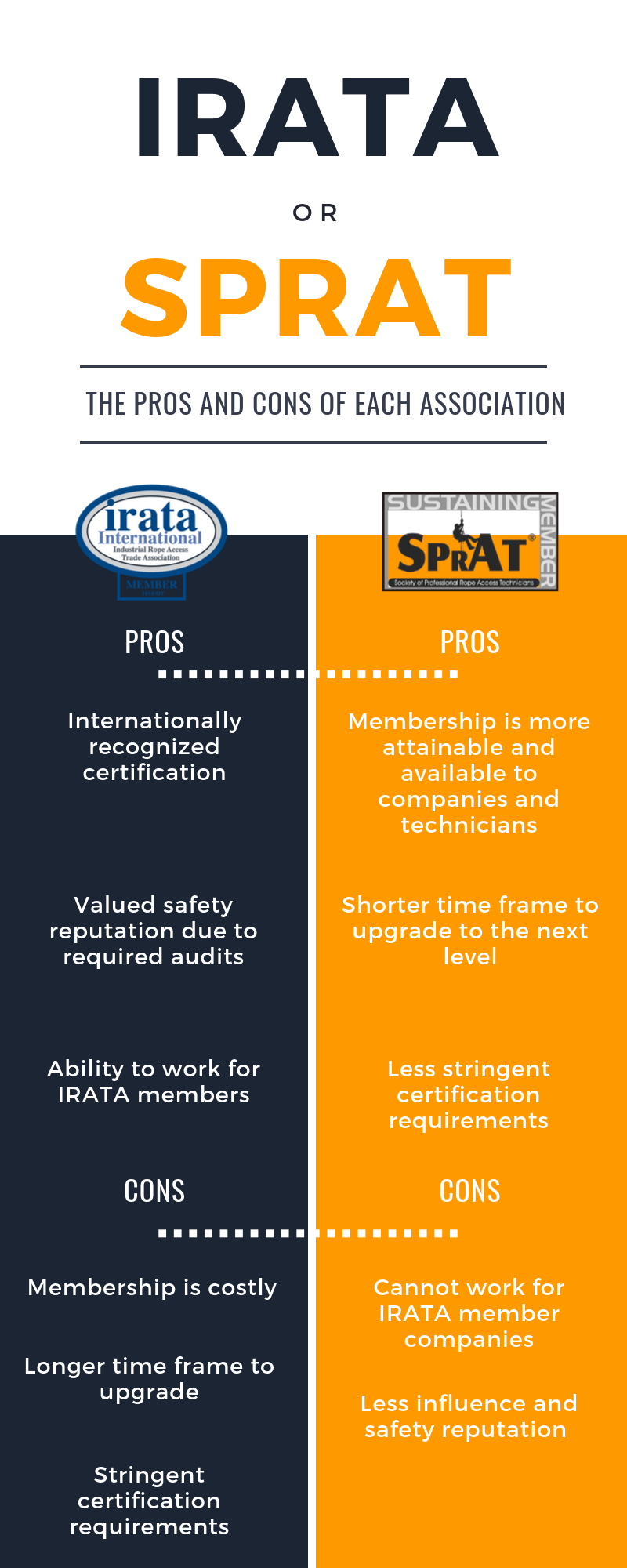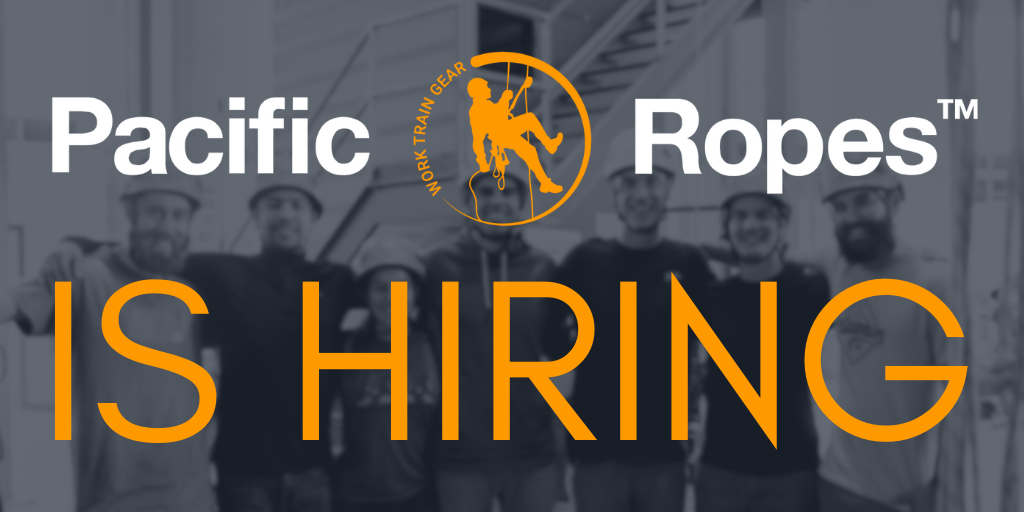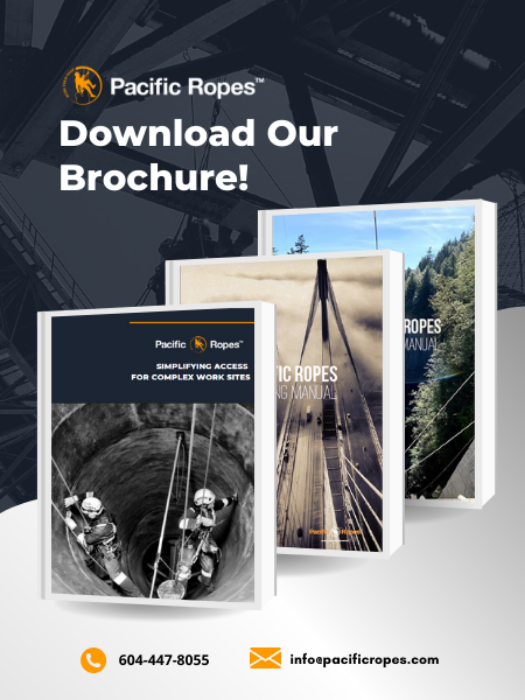
**For the technician, we've already created a blog post on how to choose between IRATA or SPRAT certification here.**
As an employer, the decision between what certifications your employees train under has immediate and long term implications for your company. Whether it is your budget, your clients, your industry, there is a lot to weigh to make the right decision, and we are here to help you unpack the process to bring you some clarity.
Although there are more than two associations for rope access globally, we we only need to concern ourselves with IRATA or SPRAT in North America.
IRATA
IRATA (Industrial Rope Access Trade Association) is based in the UK and it remains the world’s longest standing Rope Access association to date. IRATA is considered the most well-established Rope Access body internationally with over 500 member companies around the world (and counting). IRATA membership is based on company level which means only business and companies can apply for membership. Membership is granted on the condition of initial and ongoing safety audits, which may be costly for a company. Costs include IRATA auditors flying in from our of town and hiring personnel internally to manage your rope access program.
SPRAT
SPRAT (Society of Professional Rope Access Technicians) is influenced by IRATA during it's conception but was created mainly to serve the specific needs of rope access in North America. SPRAT certification is still principally recognized in North America. They have membership on the company level and the technician level. Membership is granted upon payment of a membership fee. There are no required audits.
Do I need to pick an association?
Here in North America, both IRATA and SPRAT have different influences in different regions depending on the local legislation and the industry your company operates in. In BC, WorksafeBC Part 34, is the regulation you need to refer to when conducting rope access operations anywhere in British Columbia. If you are in Alberta, WCB Alberta, Part 41 is the one you need to refer to.
WorksafeBC Part 34 does not dictate which association you need to follow. It references both.
WCB Alberta Part 41, favors IRATA but does not require you to get a membership. It requires the technicians to be IRATA certified.
That being said, both regulations dictate the requirements they want to see in a rope access team so it's important to refer to both of these regulations if you are thinking of running a rope access team in the company.
Industry Influence
The next factor to consider is if the industry you are involved in have a preference. If you are working in oil and gas in Alberta, you'll need to get an IRATA membership. Otherwise, most other industries do not dictate or have a specific preference. If you're in an industry that does not specify which certification is preferred then you will need to consider the probability of which one they will choose in the future as rope access influence grows. What values and trends do you recognize in your industry? What do your clients care about?
For example, the oil and gas industry places importance and emphasis on safety in the work place. IRATA meets that requirement because IRATA members are required to go through audits to maintain high safety standards for rope access training and services. Although SPRAT has similar expectations of how a rope access team is conducted, they don't perform audits on their members to ensure all standards are being met.
On the contrary, SPRAT is highly used in the Engineering industry in the states. Why? Because SPRAT itself was created and built by individuals involved in Civil Engineering. SPRAT was originally manifested to serve the needs of this industry although it's grown now to encompass more than civil infrastructure. Nevertheless, SPRAT influence remains strong here.
In BC, the high rise maintenance industry favors SPRAT. This trend was mainly due to the fact that in the SPRAT certification system, technicians can upgrade quicker than IRATA. This meant that if you were to invest in an employee, that employee can become a L3 Supervisor quicker in the SPRAT system than the IRATA system.
As you can see, industry trends can vary significantly for diverse reasons. To begin, sit down and think about where your industry started, how it's evolved, and where you think it will go. What do you think your clients will want in the future?
When there is no local legislation on rope access
Generally, this means that your local legislation body is not aware or educated on the benefits of rope access. If you're using rope access, it's probably because you see the value that this will bring to your clients. At this point, you can operate within SPRAT or IRATA or a mix of both and it wouldn't matter. The problem with it not being legislated is that your competitor may also offer rope access but not under either association, therefore allowing them to underbid because they can cut costs including sending untrained employees to do rope access.
Using BC as an example, our rope access regulation came into effect because we wanted it. There was enough rope work happening that we wanted there to be some standardization across the industry. So as a collective, we made enough noise for them to look into it. In the end, our regulation here stipulates that either IRATA or SPRAT are acceptable but in order to do any rope access work, all technicians need to be certified by one or other. Which leads us to our next question.
How does each certification influence my rope access teams?
Both IRATA and SPRAT have three levels of certification. There are a few minor differences in the levels between the associations but generally, a level 1 IRATA can perform and have the same responsibilities as a SPRAT level 1.
The main difference comes in how soon a technician can upgrade. For SPRAT, they require 500 hours and 6 months of rope access experience while IRATA stipulates that you need 1000 hours and 1 year of rope access experience. So if you need to have Supervisors sooner rather than later, a SPRAT certification will help you achieve that.
Along the same lines, general certification procedures for IRATA are more stringent than SPRAT certification procedures. When it comes to upgrading, logbooks, expired certificates, and direct entries, IRATA has a lot more requirements and stipulations than SPRAT.
A thorn for some companies that we have seen is that if they invest their money into providing IRATA certifications for their employees, many employees don't fully commit to their contracts because with an IRATA certification, there tends to be more job opportunities knocking on their doors. IRATA is internationally recognized so their IRATA certification can provide them work beyond where they live. IRATA technicians can work for IRATA companies and other rope access companies while SPRAT technicians cannot work for IRATA member companies.
Teams with both SPRAT and IRATA certifications
In the most recent months, we have seen that having a mix of certifications has been harder to manage than having one team with the same certifications. Even though skills and abilities are similar across IRATA and SPRAT levels, the regulation and expectations behind the roles of each level differ enough that it can cause confusion and ambiguity within the teams, which can lead to potential safety hazards. At the end of the day, if you plan to manage your own rope access team, you'll need to have a full rope access program that outlines all of these decisions. And, it is much easier to have a rope access program based on either IRATA or SPRAT rather than one that mixes and matches them both as the standard practices between both vary quite a bit.
Summary
Now, it's time to do a bit of Q&A with yourself or your team to decide which direction your company should take in order to maximize the efficiency of your rope access team. Use the chart of pros and cons at the beginning of this blog post to help you decipher your answers!
- What are the Values and goals of your rope access team? Which association aligns with those goals?
- What are the values and goals of your industry? Which association aligns with those goals?
- What are the values and goals of your clients? Which association aligns with their goals?
If you decide you want to provide rope access to your clients but do not plan to develop your own rope access management program, you can reach out to us! We help multiple clients manage rope access work on their projects by providing training, equipment, and rope access management on site.
Have more questions? Feel free to send us a message through the chat system. Or, contact us below.



